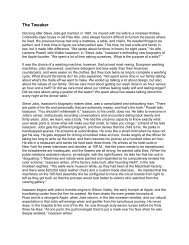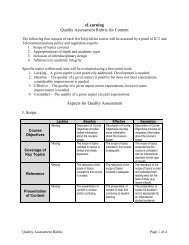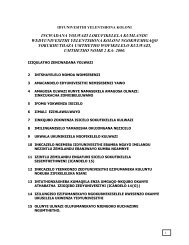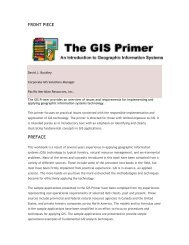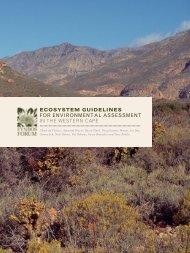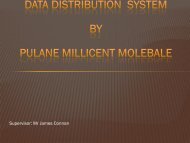Chapter 1 - University of the Western Cape
Chapter 1 - University of the Western Cape
Chapter 1 - University of the Western Cape
You also want an ePaper? Increase the reach of your titles
YUMPU automatically turns print PDFs into web optimized ePapers that Google loves.
(IUCN) notes that this can, in<br />
turn, have additional negative<br />
impacts on biodiversity, by concentrating<br />
local resource use in smaller<br />
areas and/or by undermining local<br />
resource management systems<br />
(WCPA 2000).<br />
In addition to resource depletion<br />
and habitat disruption, littering<br />
and water pollution are problems<br />
associated with mainstream<br />
tourism that can have negative<br />
consequences for biodiversity conservation.<br />
e littering problem is<br />
exacerbated in remote areas, where<br />
waste collection can be logistically<br />
difficult (e.g., on mountains, in<br />
<strong>the</strong> middle <strong>of</strong> <strong>the</strong> ocean). Waste<br />
disposal from cruise ships has<br />
been problematic, as <strong>the</strong>y have<br />
limited capacity to carry all <strong>the</strong>ir<br />
waste until <strong>the</strong>y reach <strong>the</strong>ir home<br />
port, and destination ports have<br />
limited incentive (and capacity) to<br />
accommodate periodic discharges.<br />
However, “most <strong>of</strong> <strong>the</strong> major cruise<br />
lines have begun to implement<br />
comprehensive waste management<br />
programs and wastes such as glass,<br />
Box 4: Tourism’s Resource Consumption<br />
cardboard, aluminum and steel<br />
cans are processed onboard through<br />
crushing, reuse and/or recycling<br />
and incineration” (Sweeting &<br />
Wayne 2003). Construction <strong>of</strong><br />
hotels, recreation, and o<strong>the</strong>r facilities<br />
<strong>of</strong>ten leads to increased sewage<br />
pollution. Wastewater has polluted<br />
seas and lakes surrounding tourist<br />
attractions, damaging <strong>the</strong> flora and<br />
fauna.<br />
Coral reefs are at a particular<br />
risk from unplanned tourism development.<br />
Holden (2000) notes that,<br />
as well as being mined for building<br />
materials, reefs suffer from sewage<br />
run<strong>of</strong>f that stimulates <strong>the</strong> growth<br />
<strong>of</strong> algae, covering <strong>the</strong> filter-feeding<br />
corals and hindering <strong>the</strong>ir ability to<br />
survive. In addition, reefs are <strong>of</strong>ten<br />
damaged by <strong>the</strong> activities <strong>of</strong> careless<br />
tourists—as divers and snorkelers<br />
kick and stand on coral, for example,<br />
or boats and jet skis scrape <strong>the</strong><br />
surface <strong>of</strong> <strong>the</strong> reef. Fur<strong>the</strong>rmore,<br />
dive/snorkel boat operators may<br />
throw <strong>the</strong>ir anchors into corals, and<br />
local entrepreneurs <strong>of</strong>ten break <strong>of</strong>f<br />
pieces <strong>of</strong> coral to sell as souvenirs.<br />
Using consumption averages from various countries, statistics from WTO, and estimates <strong>of</strong><br />
national tourism in relation to international arrivals, UNEP proposed some estimates <strong>of</strong> <strong>the</strong><br />
order <strong>of</strong> magnitude <strong>of</strong> resource consumption from tourism.<br />
If <strong>the</strong> global tourism industry were represented as a country, it would consume resources at<br />
<strong>the</strong> scale <strong>of</strong> a nor<strong>the</strong>rn developed country.<br />
International and national tourists use 80 percent <strong>of</strong> Japan’s yearly primary energy supply<br />
(5,000 million kWh/year), produce <strong>the</strong> same amount <strong>of</strong> solid waste as France (35 million<br />
tons per year), and consume three times <strong>the</strong> amount <strong>of</strong> fresh water contained in Lake<br />
Superior, between Canada and <strong>the</strong> United States, in a year (10 million cubic meters).<br />
Mountains are also popular<br />
locations for tourism and, because<br />
<strong>of</strong> <strong>the</strong>ir fragile soils, <strong>the</strong>y are particularly<br />
sensitive to environmental<br />
impacts. Deforestation from tourism<br />
(through construction, use <strong>of</strong><br />
wood for fires, etc.) can have direct<br />
implications for habitat conservation<br />
and watershed management<br />
and can also increase <strong>the</strong> likelihood<br />
<strong>of</strong> landslides.<br />
It is <strong>the</strong>se negative impacts <strong>of</strong><br />
unmanaged tourism development<br />
on <strong>the</strong> environment and local cultures<br />
that gave rise to ecotourism in<br />
<strong>the</strong> 1980s and 1990s as an alternative<br />
set <strong>of</strong> principles and practices<br />
to harness tourism’s economic<br />
potential for biodiversity conservation<br />
and sustainable development.<br />
During <strong>the</strong> last decade, ecotourism<br />
has emerged from small model<br />
projects demonstrating how tourism<br />
can be a catalyst for conserving<br />
nature and promoting <strong>the</strong> wellbeing<br />
<strong>of</strong> local peoples into a wider<br />
set <strong>of</strong> sustainable tourism principles<br />
that can be applied across a larger<br />
segment <strong>of</strong> <strong>the</strong> travel and tourism<br />
industry. However, just how far,<br />
and to what degree, <strong>the</strong>se principles<br />
will ultimately be able to transform<br />
<strong>the</strong> mass tourism industry to be a<br />
more positive force for biodiversity<br />
conservation remains to be seen.<br />
Endnotes<br />
3<br />
e WTTC commonly quotes this figure, although <strong>the</strong> WTO<br />
puts <strong>the</strong> figure lower. e difference reflects <strong>the</strong> difficulty<br />
in defining what is and is not included within <strong>the</strong> tourism<br />
“industry” and whe<strong>the</strong>r services such as transport are included<br />
in <strong>the</strong> calculation. e WTTC figure also incorporates <strong>the</strong><br />
multiplier effect <strong>of</strong> tourism spending and <strong>the</strong>refore reflects <strong>the</strong><br />
economic impact <strong>of</strong> <strong>the</strong> wider “tourism economy” ra<strong>the</strong>r than just<br />
<strong>the</strong> industry itself.<br />
4<br />
WSSD focused on water, energy, health, agriculture, and<br />
biodiversity (WEHAB Working Group 2002).<br />
TOURISM AND BIODIVERSITY: MAPPING TOURISM’S GLOBAL FOOTPRINT<br />
7





